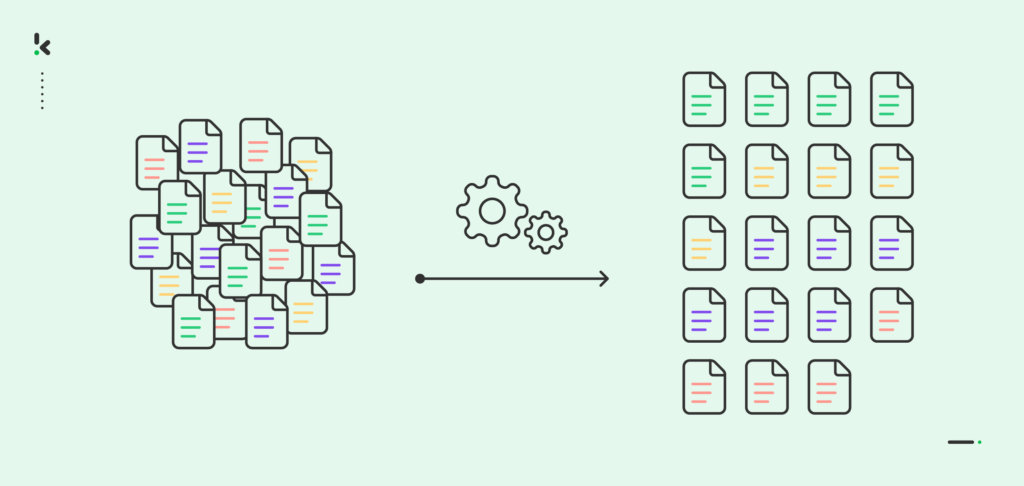

With technology moving so move fast, and continued developments in Artificial Intelligence (AI), there are constant changes and advancements in how we do things. This is especially true when it comes to document management. Manual tasks, once taken on by employees can now be automated to achieve profitable operational efficiency.
Traditional document management methods often demand time and resources, with a McKinsey report suggesting that employees spend 1.8 hours every day searching and gathering information. That’s 9.3 hours per week on average! With automated document sorting, businesses and organizations can efficiently organize documents.
In this blog, we will take you through what document sorting entails and the challenges that are faced in document sorting workflows. Additionally, we will explore how document sorting software, with the help of AI, can optimize the experience and efficiency of these workflows. Let’s dive right in.
What is Document Sorting?
Document sorting is the process of categorizing and organizing documents based on specific criteria. These categories include document types, client names, dates, and more. By systematically arranging documents, organizations are more easily able to access and retrieve information more efficiently.
Whether contracts, reports, or invoices, sorting brings order to both physical and digital files. For example, an employee might manually review a document, determine the right department, and ensure it’s archived. But this becomes a hassle with large volumes of documents.
Today, companies are shifting away from paper-based processes to boost productivity. That’s where AI-powered document sorting comes in—scanning and sorting documents efficiently, reducing errors, and transforming workflows. Let’s explore how AI simplifies this process.
How Does Document Sorting Using AI Work?
AI-powered document sorting combines Optical Character Recognition (OCR), AI, and Natural Language Processing (NLP). OCR quickly digitizes printed text, AI enhances categorization using pattern recognition, and NLP identifies key themes and relationships. Together, these technologies streamline scanning, extraction, and sorting, making processes more efficient for both employees and machines. Here’s a breakdown of the sorting process:
- Data Capture: Documents are scanned or digitally imported into the system. OCR technology then extracts text, images, and other relevant data fields from these documents.
- Data Analysis: The extracted data is analyzed by AI algorithms and then exported in a JSON format. These algorithms identify patterns, keywords, and contextual information within the documents.
- Classification: Based on the analysis, the AI categorizes the documents into predefined categories or tags. For example, invoices could be sorted as “Financial Documents,” while contracts could be tagged as “Legal Documents.”
- Sorting and archiving: The categorized documents are then organized into a digital archive. This archive is often searchable, allowing users to locate specific documents using keywords or tags quickly.
These are the general steps that occur during AI document sorting. Overall, they introduce many benefits to the workflows of your business. In the next section, we will go over who benefits from automated document sorting and how.
Who Can Benefit from Automated Document Sorting?
Alright, so we’ve talked about how automated document sorting works, lets now now dive into how different sectors and industries can harness the power of document sorting software to their advantage.
- Financial Documents: Financial institutions like banks, and accounting firms can use automated document sorting to categorize and manage documents such as invoices, receipts, bank statements, and transaction records. Not only is this beneficial for efficient internal workflows, but it also ensures compliance with industry regulations and reduces fraud.
- Healthcare Documents: Healthcare providers manage vast volumes of patient records, medical reports, and regulatory documents. Automated document sorting can organize patient information, treatment records, and compliance documents seamlessly. This ensures medical professionals can access relevant patient data promptly, leading to better patient care and adherence to privacy regulations.
- Legal Documents: Legal document management is complex, encompassing contracts, cases, and correspondences. AI-powered sorting enhances categorization by case, dates, and departments. This is crucial for significant legal actions like Cartel damage claims, optimizing efficiency, research, and collaboration. Efficient sorting accelerates case prep and safeguards client confidentiality.
- Human Resources: Document sorting software enables HR professionals to efficiently categorize documents such as employee records and resumes based on predetermined criteria like employee name, or department. This leads to streamlined recruitment, simplified compliance with labor laws, and better employee management.
Essentially, document sorting using AI introduces flexibility and efficiency that transcends industry boundaries. Its ability to categorize and organize documents based on tailored criteria empowers individuals and organizations to easily navigate complex workflows. Let’s see what this looks like in practice in the next section with the help of an automation solution.
How to Sort Documents with AI using Klippa
How does document sorting work with Klippa? Well, in this section we will show you what the steps look like using our IDP platform. We will be using financial documents as an example however, you can process a wide range of documents with our platform.
Step 1: Sign Up on the Platform
The first thing to do is to sign up for the DocHorizon Platform. Simply fill in your name and email address to get started. You will instantly receive a free credit of €25 to test all the capabilities of the platform.
Step 2: Configuration for Financial Document
To work with financial documents on the platform, you’ll need to configure the financial document capturing model and your presets to start enabling classification and sorting of the documents that need to be sorted. Turn on the document classification component from the list. At this step, you can also turn on the other components like the hash to enable invoice duplicate detection for example.
This step is necessary for processing financial documents, if you need to sort other types of documents you can easily skip this step.
Step 3: Set up the Flow
To start the flow in the flow builder, you need to select the “controls” component from the list of utilities and select “On Start” from the list of actions. This means once you have set up the whole flow, for every file in the folder, the subsequent actions will take place.
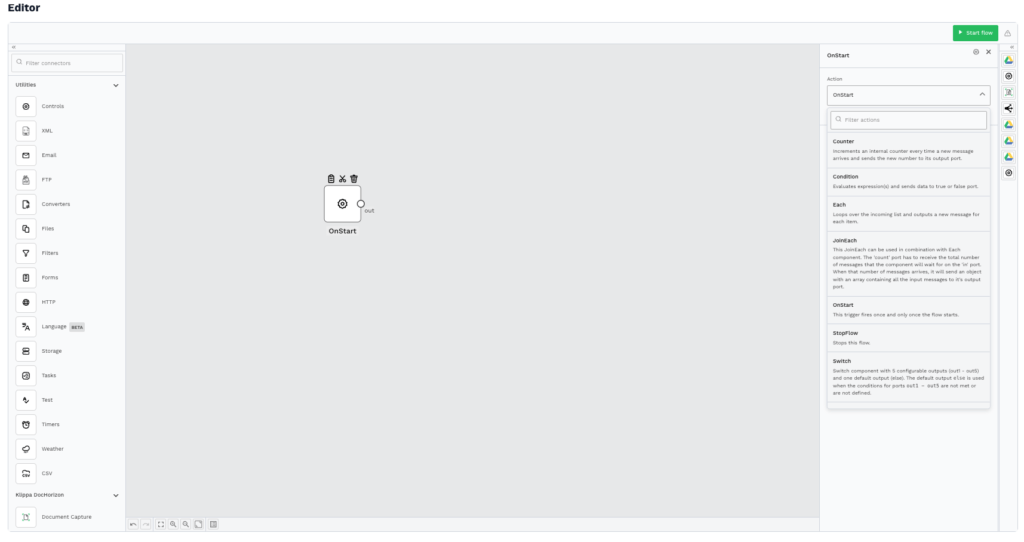

Step 4: Select the Input Source
In this scenario, we have all our financial documents in a Google Drive folder. This means the documents that need to be sorted will be retrieved from a Google Drive folder and subsequently placed in the folder.
So from the list of utilities select the Google Drive icon and from the list of actions select “list files”. You’ll be presented with some boxes that need filling in.
- Folder location: Here you should select the location of the folder with the documents you need sorting.
- Search type: Here you should select “Exact file name” from the dropdown menu.
- Output Type: Here you need to select “File”.
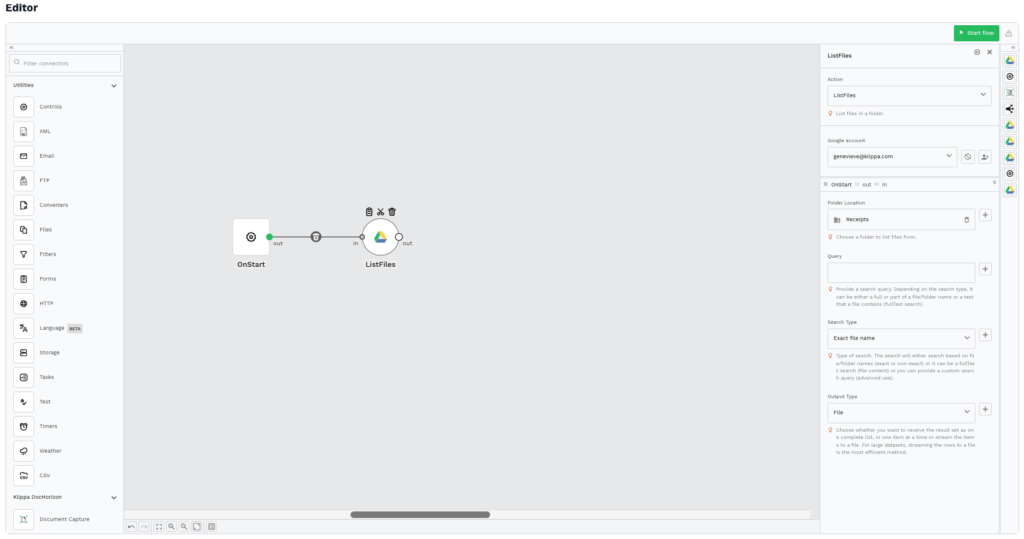

Step 5: Data Extraction and Classification
Select the Financial document capture model from the list of utilities. You’ll need to input a value into the “Preset” which you configured in step 2. This enables the classification and document sorting to take place.
Our API is capable of discerning between three main financial document types; Invoices, Receipts, and Others.
However, for each of the main classifications, there is a subclassification that indicates the sector to which this document belongs. There are 11 possible subclassifications including, financial_services, governmental, and hospitality. Depending on your needs, you can either have the documents sorted according to the main financial types or the subclassifications.
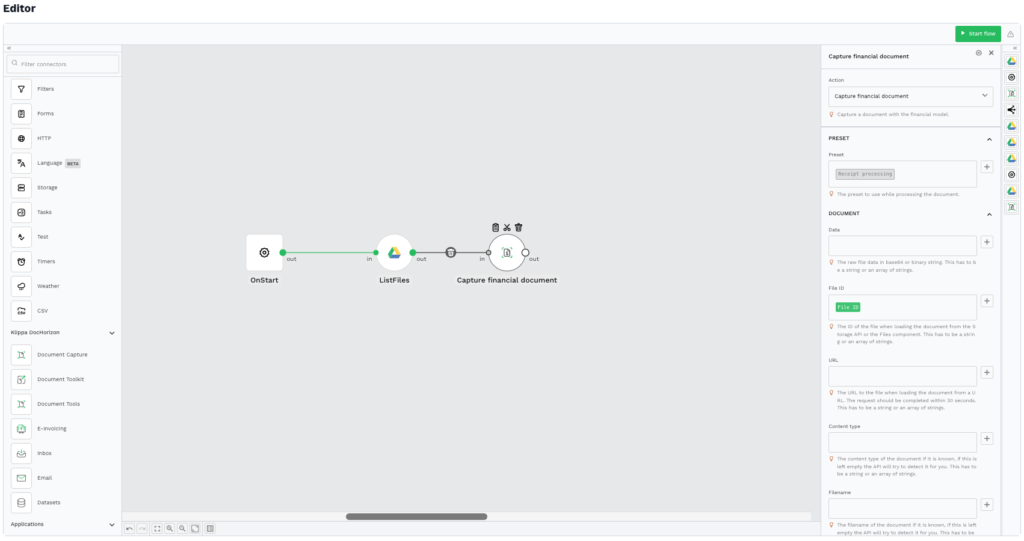

Step 6: Configure the Input and Output
Select from the list of actions “Switch” and select the following from the drop-down
Input value: data.components.document_classification.value
Assertion type: Equal
Expected Value: receipt
You can repeat these steps in the field labeled Output 2 and Output 3, substituting the expected value for invoice and other.
This step takes the JSON output from the capture step (step 5) and determines if it matches the “Expected value”. This is essentially the document type or document classification you want to be checked and sorted into different folders.
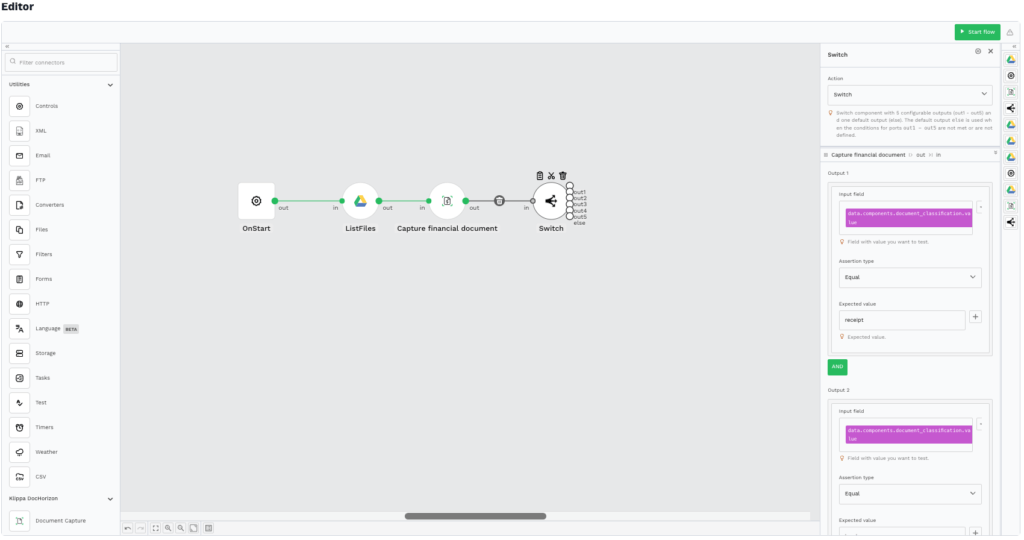

Step 7: Select Output Destination
For the last step, you need to select the output destination of the documents the platform has sorted. Select the Google Drive component from the list of utilities, select “MoveFileOrFolder” from the list of actions and select the name of the folder you need the documents placed. Using the folders you have already created, you can ensure that the platform each type of document into its designated destination. In other words, receipts end up in the receipt folder, invoices, etc.
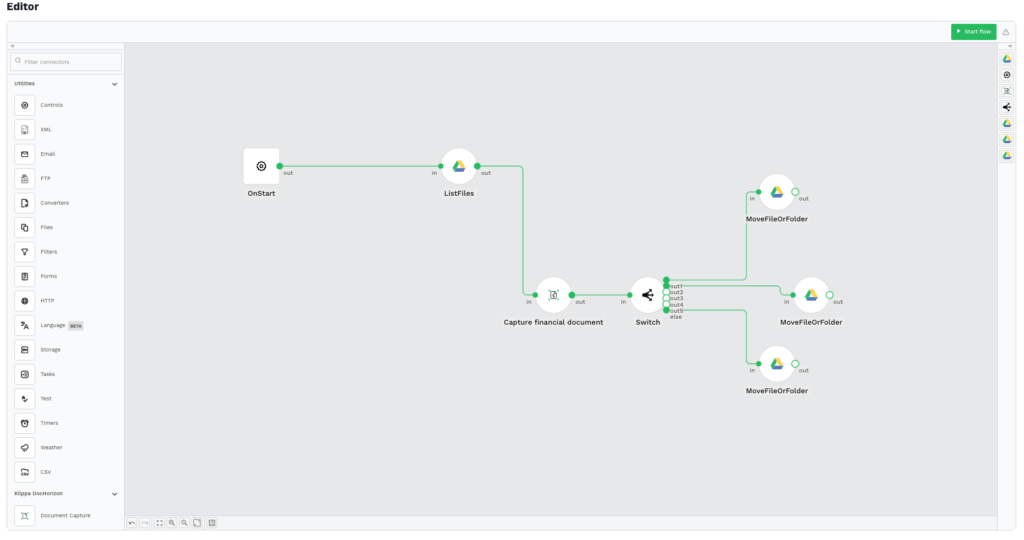

That’s it! You can use this flow to sort and process financial documents with ease. Although we have illustrated these processes with financial documents, you can use the DocHorizon platform to process a wide range of document types.
Benefits of AI in Document Sorting
Let’s explore some of the advantages of using AI in document management.
- Time-Saving: Automated document sorting drastically reduces the time spent manually organizing documents. What once took hours can now be accomplished in a fraction of the time, allowing your employees to use their time more valuably.
- Fraud Detection: With AI, you can better safeguard your business against document fraud. Through image and EXIF analysis, you can identify duplicates and fraud indicators from early stages.
- Efficiency: With automated sorting, your documents can be better organized and easily searchable. Your teams can collaborate more effectively and access the information they need easily.
- Enhanced Compliance: For GDPR enhanced compliance, automated sorting ensures that documents are appropriately categorized and stored, aiding compliance efforts.
- Resource Optimization: Automated document sorting can reduce previously labor-intensive tasks, and allocate human resources to more strategic and valuable activities.
- Cost Reduction: Reduced reliance on manual labor for sorting means lower operational costs in the long run.
The great news is, that these benefits can be experienced across industries, and with the right solution you can transform the way you approach document management! Although there are many solutions on the market not all are equal. Klippa Dochorizon stands out in the crowd for what it offers. To conclude, we can dive into learning more about what our solution offers.
Intelligent Document Sorting with Klippa
Klippa DocHorizon is an Intelligent Document Processing (IDP) platform that enables you to automate the workflows from document conversion to sorting and archiving. By integrating various Klippa DocHorizon modules and your preferred applications, you can create an effortless and unique workflow to suit your needs.
- Create Custom Workflows: Design personalized document workflows by linking various DocHorizon features such as data extraction, capture, conversion, anonymization, verification, classification and more.
- Enjoy Extensive Document Compatibility: Handle documents in any Latin-based language, and tailor data fields for extraction based on your specific requirements.
- Seamless Integration: Our platform supports over 50 integration options, allowing easy connection with cloud solutions, email parsing, CRM, ERP, and accounting software.
- Security & Compliance: With ISO 27001 & 9001 certification and GDPR compliance, Klippa ensures your data remains secure and adheres to regulatory standards.
- Scalability: Klippa’s bulk upload feature lets you efficiently sort files simultaneously, accommodating your growing business needs.
- Data Management: Streamline processes for better data organization, enabling quick search, retrieval, and analysis to support informed decision-making.
Ready to embark on a journey of enhanced efficiency and organization? Schedule a free online demo today or engage with our experts to fully uncover the transformative capabilities of Klippa’s file sorting and classification solution!